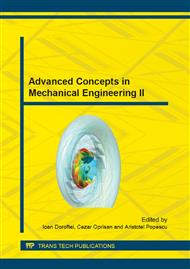[1]
V. Carlescu, Dumitru Olaru, Gheorghe Prisacaru, Stelian Vlad, Determining the stress-strain curve of PDMS-SiO2-TiO2 electroactive polymers, Mechanical Testing and Diagnosis, Vol. 2 (2012) 54-61.
Google Scholar
[2]
A. Hamdi, M. Naït Abdelaziz, N. Aït Hocine, P. Heuillet, N. Benseddiq, A fracture criterion of rubber-like materials under plane stress conditions, Polymer Testing 25 (2006) 994–1005.
DOI: 10.1016/j.polymertesting.2006.06.005
Google Scholar
[3]
Mooney M., A theory of large elastic deformation. J. Appl. Phys. 11 (1940), 582–592.
Google Scholar
[4]
Rivlin R. S., Large elastic deformations of isotropic materials. iv: Further developments of the general theory. Philos. Trans. R. Soc. Lond. A241 (1948) 379.
DOI: 10.1098/rsta.1948.0024
Google Scholar
[5]
Ogden R. W., Non-Linear Elastic Deformations, Dover Publications Inc., Mineola, NY, USA, (1984).
Google Scholar
[6]
Holzapfel G. A., Nonlinear Solid Mechanics, John Wiley and Sons, New York, (2000).
Google Scholar
[7]
Lai W. M., Rubin D. and Krempl E., Introduction to Continuum Mechanics, 3rd edition, Butterworth Heinemann, (1996).
Google Scholar
[8]
Carpi F., Danilo De Rossi, Roy Kornbluh, Ronald Pelrine and Peter Sommer-Larsen, Dielectric elastomers as electromechanical transducers – Fundamentals, Materials, Devices, Models and Applications of an emerging electroactive polymer technology, Elsevier, (2008).
DOI: 10.1016/b978-0-08-047488-5.00033-2
Google Scholar
[9]
Mihai AVRAM, Constantin BUCSAN, Hydraulic and pneumatic actuating systems with piezoelectric actuators, Romanian Review Precision Mechanics, Optics and Mechatronics (43) (2013) 7-11.
Google Scholar
[10]
Vu D.K., P. Steinmann, A 2-D coupled BEM-FEM simulation of electro-elastostatics at large strain, Comput. Methods Appl. Mech. Engrg. 199 (2010) 1124-1133.
DOI: 10.1016/j.cma.2009.12.001
Google Scholar
[11]
Park Harold S., Zhigang Suo, Jinxiong Zhou, Patrick A. Klein, A dynamic finite element method for inhomogeneous deformation and electromechanical instability of dielectric elastomer transducers, International Journal of Solids and Structures 49 (2012).
DOI: 10.1016/j.ijsolstr.2012.04.031
Google Scholar
[12]
Zhan Gao, Alisar Tuncer, Alberto M. Cuitiño, Modeling and simulation of the coupled mechanical–electrical response of soft solids, International Journal of Plasticity 27 (2011) 1459–1470.
DOI: 10.1016/j.ijplas.2010.07.006
Google Scholar
[13]
A. Dorfmann, R.W. Ogden, Nonlinear electroelastostatics: Incremental equations and stability, International Journal of Engineering Science 48 (2010) 1–14.
DOI: 10.1016/j.ijengsci.2008.06.005
Google Scholar
[14]
Hoss L., Hyperelastic Constitutive Models for Incompressible Elastomers: Fitting, Performance Comparison and Proposal of a New Model, M. Sc. thesis, UFRGS, (2009).
Google Scholar
[15]
Steinmann Paul, Mokarram Hossain, Gunnar Possart, Hyperelastic models for rubber-like materials: consistent tangent operators and suitability for Treloar's data, Arch Appl Mech (2012) 82: 1183–1217.
DOI: 10.1007/s00419-012-0610-z
Google Scholar
[16]
H. Khajehsaeid, J. Arghavani, R. Naghdabadi, A hyperelastic constitutive model for rubber-like materials, European Journal of Mechanics A/Solids 38 (2013) 144-151.
DOI: 10.1016/j.euromechsol.2012.09.010
Google Scholar
[17]
Alexandru M., Cazacu M., Nistor A., Musteata V. E., Stoica I., Grigoras C., Simionescu B. C.: Polydimethylsiloxane/silica/titania composites prepared by solvent-free sol–gel technique, Journal of Sol-Gel Science and Technology 56 (2010) 310–319.
DOI: 10.1007/s10971-010-2307-5
Google Scholar
[18]
Alexandru M., M. Cazacu, F. Doroftei, M. Ignat, D. Timpu, C. V. Grigoras, B. C. Simionescu, On the morphology and potential application of polydimethylsiloxane-silica-titania composites, eXPRESS Polymer Letters Vol. 5, No. 2 (2011) 188–196.
DOI: 10.3144/expresspolymlett.2011.17
Google Scholar
[19]
V. Carlescu, Stelian Vlad, Gheorghe Prisacaru, Dumitru Olaru, Mechanical testing of elastomers for sensor and actuator applications, TEHNOMUS - New Technologies and Products in Machines Manufacturing Technologies, No. 21 (2014) 80-86.
Google Scholar
[20]
P. Maboo Subhani and R. Krishna Kumar, A New Stored Energy Function for Rubber Like Materials for Low Strains, Mechanics of Advanced Materials and Structures 16 (2009) 402–416.
DOI: 10.1080/15376490902781167
Google Scholar
[21]
Aidy Ali, M. Hosseini and B B Sahari, A review and comparison on some rubber elasticity models, Journal of Scientific & Industrial Research Vol. 69 (2010) 495-500.
Google Scholar
[22]
M. Sasso, G. Palmieri, G. Chiappini, D. Amodio, Characterization of hyperelastic rubber-like materials by biaxial and uniaxial stretching tests based on optical methods, Polymer Testing 27 (2008) 995–1004.
DOI: 10.1016/j.polymertesting.2008.09.001
Google Scholar


